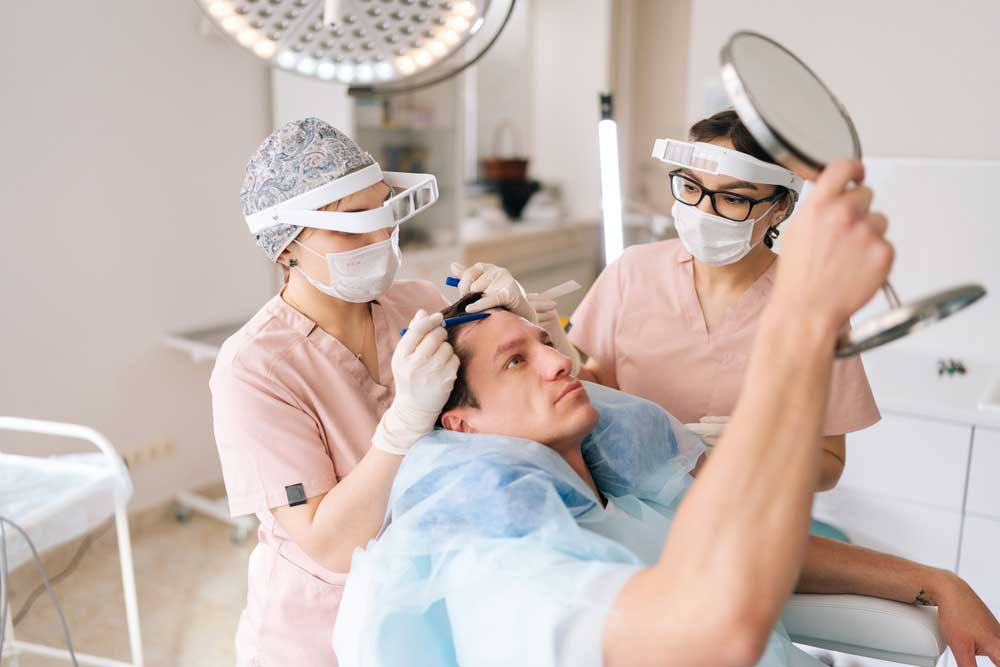Many products on the market claim to address hair loss, but the best results come from experts who understand the complexities of hair restoration. At New Jersey Hair Restoration Center in Freehold, NJ, we specialize in examining each patient, identifying the root causes of hair loss, and matching patients with treatments that actually work for their specific conditions. We have helped many patients achieve healthier, thicker hair through our expertise in hair restoration.
The Causes of Hair Loss
Genetics
Genetics is one of the most common reasons for hair loss. If your family has a history of hair thinning or baldness, you might be more likely to experience it too. This type of hair loss is often predictable and can start as early as your 20s.
Hormonal Changes
Hormonal changes can trigger hair loss at different stages of life. Conditions such as pregnancy, menopause, and thyroid imbalances often cause changes in hair growth. These fluctuations can lead to temporary or long-term hair thinning.
Medical Conditions
Certain medical conditions can cause hair loss like alopecia areata, scalp infections, and autoimmune disorders. Sometimes certain medications can also cause or exacerbate hair loss. When you work with us, we can find ways to support your hair health in many of these complex situations.
Stress and Lifestyle
High levels of stress and an unhealthy lifestyle can contribute to hair loss. Poor diet, lack of sleep, and intense emotional or physical stress can weaken hair and cause it to fall out. Improving your lifestyle can help mitigate these effects.
Early Signs of Hair Loss
- Thinning Hair: Thinning hair is often the first noticeable sign of hair loss. You might see more scalp than usual, or your hair might appear less full than before. Thinning hair can progress gradually, sometimes making it hard to catch early.
- Receding Hairline: A receding hairline typically starts around the temples and moves back across the scalp. This is a common sign of male pattern baldness, but it can affect women as well. Early intervention can help slow down the process.
- Bald Patches: The appearance of bald patches is a clear indication of hair loss. These can occur anywhere on the scalp and vary in size. Prompt treatment is important for preventing further hair loss.
The Importance of Choosing the Right Hair Restoration Treatment
Choosing the right hair restoration treatment will help you to get longer-lasting results that also look natural and healthy. Different types of hair loss require different approaches, so it’s essential to match the treatment to your specific condition.
By selecting solutions that fit the patient, we can address the root causes of hair loss and help our patients see more noticeable improvements. When you work with a specialist in hair loss, you are more likely to get a treatment plan that works for you.
PepFactor for Hair Restoration
What Is PepFactor?
PepFactor is a thinning-hair treatment that promotes hair growth by combining peptides with the patient’s own blood plasma. This treatment stimulates fibroblasts, enhancing collagen and elastin production and reducing balding or thinning patches. The treatment consists of non-invasive injections and provides rapid, long-lasting results with natural-looking hair regrowth.
How PepFactor Works
PepFactor works by injecting a mixture of polypeptides and plasma into the scalp. This combination revitalizes the hair follicles and promotes increased hair density, improved scalp health, and thicker hair strands. This method of hair restoration leverages the body’s natural healing processes to achieve robust and sustainable hair growth.
Medical Management for Hair Loss
Finasteride
Finasteride is a hair restoration treatment that targets the hormone responsible for hair loss. By inhibiting the conversion of testosterone to dihydrotestosterone (DHT), finasteride helps reduce hair thinning and promotes regrowth. Taken orally, it is particularly effective for men experiencing male pattern baldness. Consistent use can result in noticeable improvements over several months, with continued use necessary to maintain results.
Minoxidil
Minoxidil is a topical solution applied directly to the scalp to stimulate hair growth. It works by increasing blood flow to hair follicles, providing them with more oxygen and nutrients. Minoxidil is used by both men and women to treat various types of hair loss. Regular application can slow hair loss and encourage new growth, typically showing results within a few months of consistent use.
Exosome Treatments for Hair Restoration
What Are Exosomes?
Exosomes are tiny vesicles that facilitate cellular communication and regeneration. Produced by mesenchymal cells, they carry growth factors and proteins to other cells, aiding in repair and rejuvenation. Exosome treatments use these properties as hair-thinning solutions, targeting hair follicles to promote healthier and stronger hair growth.
How Exosome Treatments Work
Exosome treatments involve applying a topical solution containing billions of exosomes to the scalp. This solution, combined with microneedling, allows the exosomes to penetrate the scalp, enhancing collagen production and revitalizing dormant hair follicles. This thinning-hair treatment leverages the body’s natural healing processes to foster robust hair growth, offering a non-surgical, non-invasive option with long-lasting results.
PRP Hair Treatments
What Is PRP?
PRP, or platelet-rich plasma, is a hair loss treatment that uses platelets in the patient’s own blood to promote hair growth. The process involves drawing a small amount of blood, which is then spun in a centrifuge to separate the plasma rich in platelets. This PRP hair treatment leverages the growth factors and proteins in the plasma to rejuvenate hair follicles and stimulate new growth.
How Does PRP Stimulate Hair Growth?
PRP stimulates hair growth by injecting the concentrated platelets into the scalp where hair loss is occurring. These platelets release growth factors that enhance tissue repair and regeneration, which is crucial for hair follicle health. The treatment increases blood flow to the hair follicles, providing essential nutrients and oxygen. This PRP hair restoration method revitalizes dormant hair follicles, prolongs the growth phase of the hair cycle, and promotes thicker, healthier hair strands.
Laser Cap Therapy for Hair Loss
What Is Laser Cap Therapy?
Laser Cap therapy is a hair loss treatment that uses low-level laser therapy (LLLT) to stimulate hair growth. The Laser Cap emits monochromatic red laser light, which targets hair follicles to delay hair loss and improve hair density. It is a portable and convenient device powered by a rechargeable battery, allowing for easy use at home.
How Low-Level Laser Therapy Works
Low-level laser therapy (LLLT) in the Laser Cap uses a 650nm wavelength red laser light to regenerate inactive hair follicles. The light energy is absorbed by cells within the hair follicle, enhancing cellular respiration and energy production. This process re-energizes the follicles, inducing the growth of healthier, denser hair. This hair restoration method revitalizes dormant follicles and stimulates natural hair growth, making it an effective and non-invasive treatment option.
Surgical Options for Hair Restoration
FUE
Follicular unit extraction (FUE) is a hair restoration treatment that involves taking individual hair follicles from a donor area and transplanting them to thinning or bald spots. This technique reduces scarring and promotes a faster recovery compared to traditional methods. FUE is favored for its minimally invasive nature and ability to produce natural-looking results.
FUT
Follicular unit transplantation (FUT) is a hair-thinning solution that involves removing a strip of scalp from the back of the head to harvest hair follicles. These follicles are then transplanted to areas experiencing hair loss. While this hair transplant method can leave a linear scar, it is effective for covering larger balding areas in a single session, providing dense and lasting results.
Find the Right Hair Restoration Treatments for You in Freehold, NJ
Achieving effective hair restoration requires selecting treatments that address your specific needs. At New Jersey Hair Restoration Center, we offer a variety of solutions, from non-surgical options like PRP and laser therapy to surgical techniques like FUE and FUT. Each method is designed to provide natural-looking, lasting results for patients in Freehold, NJ. To learn more about how we can help you regain healthier, fuller hair, please reach out to us at (732) 365-4533. You can also fill out our online form to schedule your consultation today.


